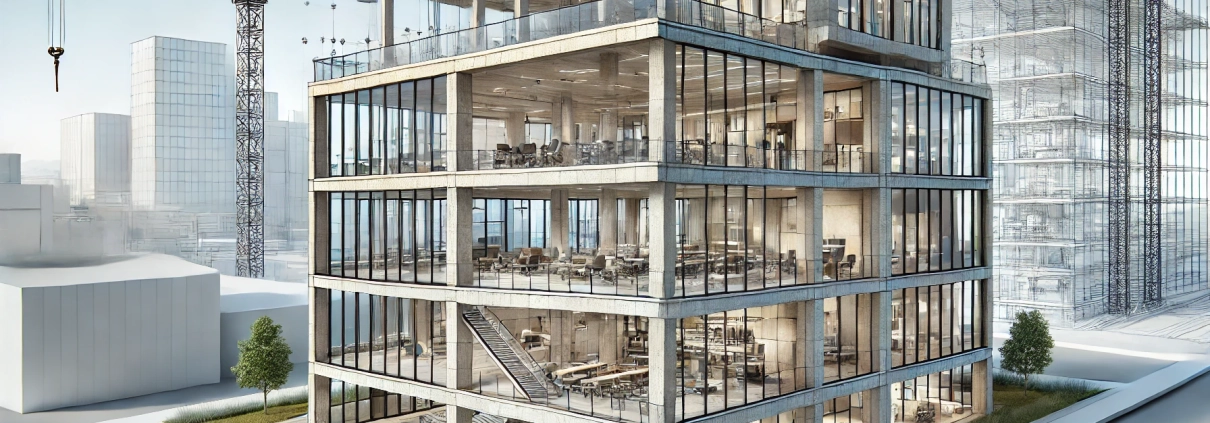Reinforced concrete
This refers to concrete in which wire mesh or steel bars are embedded into the concrete to increase its strength. In commercial real estate development and construction, reinforced concrete and steel framing add to the building’s tensile strength, which allow for higher and more complex construction. Buildings with this construction generally cost more than comparable stick-frame buildings, and thus typically merit a higher valuation in comparison.
Putting ‘Reinforced Concrete’ in Context
ClearPoint Properties, a real estate investment firm, acquired the Riverwalk Office Center in Charleston, West Virginia, as a value-add redevelopment opportunity. This three-story, 75,000-square-foot office building, constructed in the early 1980s, features a reinforced concrete structural system, which provides a solid foundation for the planned upgrades.
The building’s reinforced concrete framework not only contributes to its durability but also allows ClearPoint Properties to modernize the property without the structural limitations often encountered in stick-frame construction. The firm intends to:
- Add a rooftop terrace, leveraging the building’s ability to support additional loads due to its reinforced concrete design.
- Install larger windows by strategically removing portions of the reinforced concrete walls, which maintain sufficient structural integrity after the modifications.
- Incorporate open floor plans to appeal to modern tenants, capitalizing on the flexibility of the concrete system to reconfigure internal spaces.
Financial and Structural Impact
The redevelopment plan is projected to increase the property’s net operating income (NOI) by 30%, driven by higher rents and reduced vacancy rates due to the building’s upgraded features. The enhanced durability of the reinforced concrete ensures a longer lifespan for these improvements, further supporting a higher valuation for the property post-redevelopment.
For example, the property’s purchase price was $12 million, and ClearPoint Properties invested $4 million in renovations. Post-redevelopment, the property is expected to generate an NOI of $1.5 million, resulting in a post-renovation cap rate of 7.5%. This demonstrates the value that reinforced concrete construction adds to a redevelopment project.
Why Reinforced Concrete Matters
Without the reinforced concrete foundation, many of these improvements would be infeasible or prohibitively expensive. The inherent strength and versatility of the material enable developers to undertake projects that increase property value while maintaining structural integrity.
Frequently Asked Questions about Reinforced Concrete in Commercial Real Estate
What is reinforced concrete?
Reinforced concrete is concrete that includes embedded wire mesh or steel bars to increase its tensile strength. This makes it more suitable for large-scale or complex commercial construction projects.
How does reinforced concrete impact commercial property value?
Buildings constructed with reinforced concrete generally cost more than stick-frame buildings but merit higher valuations due to their enhanced durability, load-bearing capacity, and redevelopment potential.
How was reinforced concrete used in the Riverwalk Office Center redevelopment?
ClearPoint Properties utilized the building’s reinforced concrete framework to support a rooftop terrace, install larger windows, and create open floor plans. These modifications were made possible due to the structural flexibility and strength of reinforced concrete.
How does reinforced concrete enable modern renovations?
Reinforced concrete allows developers to make significant changes—like removing wall sections for windows or adding rooftop amenities—while preserving structural integrity. This supports tenant-demanded upgrades without compromising safety.
What financial benefits were realized from using reinforced concrete in this case?
Post-renovation, the Riverwalk Office Center is expected to produce a 30% higher NOI, driven by improved rents and lower vacancy. With an NOI of $1.5 million and a 7.5% cap rate, the upgrades significantly enhanced the property’s value.
Why is reinforced concrete preferred for some commercial projects?
Its high load-bearing capacity, durability, and flexibility make reinforced concrete ideal for multi-story office buildings and redevelopment projects that require structural modifications.
Click here to get this CRE Glossary in an eBook (PDF) format.

